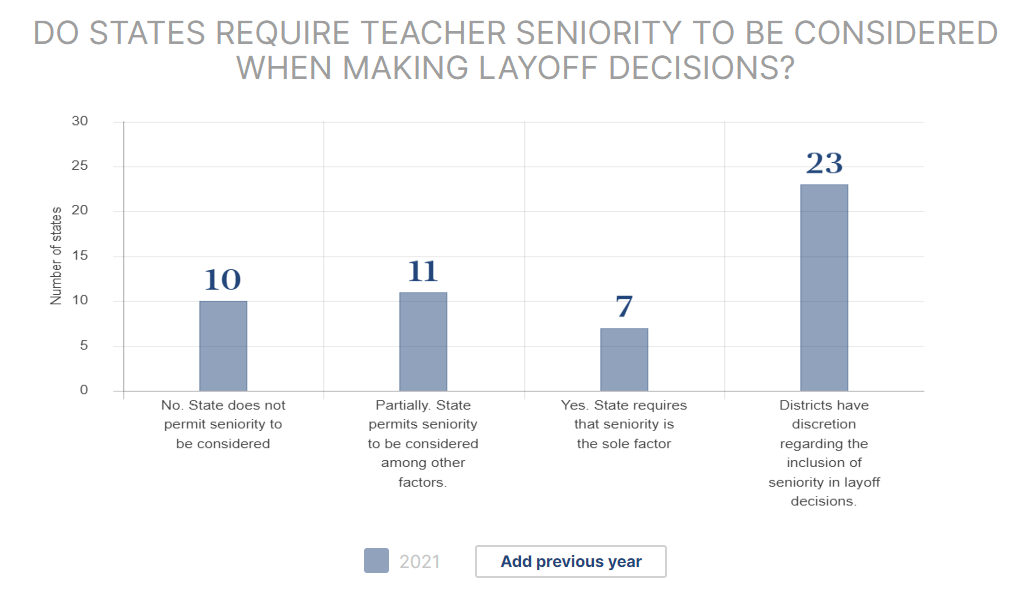It may seem tone-deaf to focus on layoffs when the news is fraught with reports of teacher shortages, but much as pandemic recovery funds helped drive these shortages by opening new positions to staff, so too will the end of those funds bring about a painful wave of layoffs. For years, districts across the country have employed a seniority-based layoff approach when making tough decisions to reduce the teaching force. This practice, known as “last-in-first-out” (LIFO), in which the last teachers hired are the first to be fired, is harmful. Not only do LIFO practices threaten the dual goals of diversifying the workforce and ensuring teacher effectiveness, but they also hurt students of color and students living in poverty the most.
Given that districts will face (or are already facing) these challenging decisions, there is no time like the present to eliminate LIFO policies.
Early signs of impending layoffs
Chad Aldeman’s recent analysis of new data from the National Center on Education Statistics in 9,500 districts across the country shows that on a per-student basis, “staffing levels hit an all-time high” in the 2022-2023 school year. Unfortunately, as Elementary and Secondary School Emergency Relief (ESSER) funds run out, many districts won’t be able to maintain current teacher staffing levels—meaning layoffs are looming. (Other analyses support this one, such as this deep dive into staffing in Washington state.) Districts simply won’t be able to afford to keep teachers on the payroll, especially in the face of significant student enrollment declines.
Why are LIFO policies so harmful?
Laying off teachers is wrenching, and when districts are not discerning about which teachers they lay off, the consequences are worse. LIFO policies harm teacher diversity and teacher quality and, in turn, negatively impact student learning.
Seniority-based layoff policies work against districts’ goals to increase teacher diversity–an essential goal given the positive impact of teachers of color on all students, especially students of color. Many states and districts have prioritized teacher diversity with positive results: The newest cohorts of teachers include more teachers of color than veteran cohorts do. But because teachers of color are more likely to be earlier in their careers, when districts use seniority as the sole criterion for layoffs, the newest group of teachers will be the first to get cut, undoing these efforts to diversify the workforce.
Besides the threat to teacher diversity, LIFO policies also put teacher quality at risk. It’s true that many first-year teachers struggle to match the higher performance of more seasoned teachers, but that difference virtually disappears by their second or third year as performance gains slow. Firing a highly effective third-year teacher over a poorly performing veteran of 15 years leaves students at a major disadvantage. Further, researchers have found that even the threat of being fired—a “pink slip” issued during a reduction-in-force (even when a teacher is re-hired later)—has negative consequences on teacher performance. Students who attend high-poverty schools are more likely to experience weakened instruction when districts issue layoff warnings, since these schools tend to employ more novice teachers.
Ultimately, it is an equity issue for students: Seniority-based layoffs disproportionately affect students of color and students living in poverty, who are more often taught by novice teachers.
How widespread are LIFO policies?
In 2021, NCTQ analyzed state laws on the use of seniority in layoff decisions. We found that only 10 states do not allow districts to consider seniority, and 18 states either permit them to consider it among other factors or require it as the sole factor. In 23 states, districts have discretion regarding the inclusion (or exclusion) of seniority in layoff decisions.

NCTQ also published a report on district layoff policies. We found that 46 of the 148 districts in our sample (nearly a third) of the largest districts across the U.S. use seniority as the primary or sole criterion for teacher layoffs. This has remained relatively stable over the past five years. In 28 of these districts, seniority is the only criterion considered when teacher layoffs need to happen. This is a troubling state of practices that will perpetuate inequities for students. We found one hopeful note: The data also showed that a more holistic approach to layoffs—using multiple criteria including performance and/or seniority—has become more prevalent; the number of districts using multiple criteria increased by roughly 10 percentage points compared to seven years ago.
What should state and district leaders do?
The writing is on the wall: Given impending budget cuts, declines in student enrollment, and the imbalance between new hires made in response to the pandemic and currently shrinking numbers of funded positions, teacher layoffs are imminent. District and state leaders need to stop focusing on teacher shortages writ large, and start focusing on policies and practices to strategically manage and staff schools.
States should begin by requiring that school districts consider classroom performance as a factor in determining which teachers are laid off when a reduction in force is necessary, and stop using seniority as the sole criterion. Where there is flexibility in state law, such as the 23 states mentioned above that give districts discretion in using or eliminating seniority, districts should seize the opportunity to eliminate seniority or at the very least, expand to additional criteria.
In addition to performance, states and districts have a variety of additional criteria to use when making tough layoff decisions:
- Specific consideration of student needs (e.g., reading specialists)
- School and district needs, such as whether a teacher has highly sought or shortage-subject qualifications (e.g., dual language speakers or special education teachers)
- School characteristics (e.g., a school designated for support because of low-performing status)
- Pathways to the classroom: whether a teacher has taken a specific, district-sponsored pathway to the classroom (e.g., Grow Your Own programs)
- Whether the teacher performs additional duties (e.g., department chair)
- The teacher’s attendance and discipline records
Many states and districts are already heeding these warnings and taking important steps. After the “Great Recession” of 2008, Charlotte-Mecklenburg Schools (NC) gave their principals discretion over layoff decisions. The principals used performance as one of their criteria, targeting teachers who earned low evaluation ratings, along with other measures, including whether teachers had previously retired, were recently hired, unlicensed, non-tenured, or taught elective subjects. Evaluation of the approach found that on average, by using these additional criteria and giving principals more discretion, the district reduced total job losses and laid off fewer effective teachers than they would have following a last-in-first-out policy.
Additionally, a recent report by E4E highlighted two examples of alternative approaches. In Minneapolis (MN), following the passage of a 2019 state law that stopped requiring the use of seniority as the only criterion in layoffs, the district and union negotiated in the contract the use of additional criteria that prioritized teacher diversity, such as keeping licensed teachers from underrepresented groups, teachers who graduated from Grow Your Own programs, and teachers in schools designated as “racially isolated.” In Oregon, advocates successfully worked to change state law so teachers with cultural or linguistic expertise are prioritized over more senior teachers. These new policies will soon be used: Minneapolis Public Schools’ (MN) most recent budget proposal indicates that about 40 teacher positions will be cut. Similarly, just last week, Salem-Keizer Public Schools (OR) announced that more than 400 public school employees will lose their jobs at the end of the school year to balance district budget forecasts.
Also hearteningly, a number of districts (Brevard Public Schools (FL), Chicago Public Schools (IL), Clayton County Public Schools (GA), Cleveland Metropolitan School District (OH), and Cobb County School District (GA), among others) have named performance as the sole criterion or the preponderant criterion for teacher layoffs. More districts can be found in our Teacher Contract Database.
Where do we go from here?
Given the rapid shifts in the teacher labor market as well as current and impending teacher layoffs, state and district policymakers, along with their unions, under the watchful gaze of local advocacy organizations, must center student needs when defining the criteria and processes to use for teacher layoffs. To advance the companion goals of diversifying the teacher workforce and supporting teacher effectiveness, we must design and implement thoughtful means of reducing the teacher workforce that will benefit all students. If we stand aside and continue with the status quo, students will suffer the costs—especially our most vulnerable and historically disadvantaged students.
More like this

OK, Boomer: Why younger generations may be more effective teachers
New research found measurable differences in teacher quality between different generations of teachers—with Baby Boomers being least effective.

Linking teachers’ instructional choices to student success
Teachers can choose from different instructional approaches, such as direct instruction, open discussion, and others, but which approach is the most effective? Does the best instructional approach depend on the subject?

Teacher layoffs may be coming. How do districts decide who to let go?
An analysis of layoff policies in 148 of the largest U.S. school districts explores how they may impact the teacher workforce and the student population

